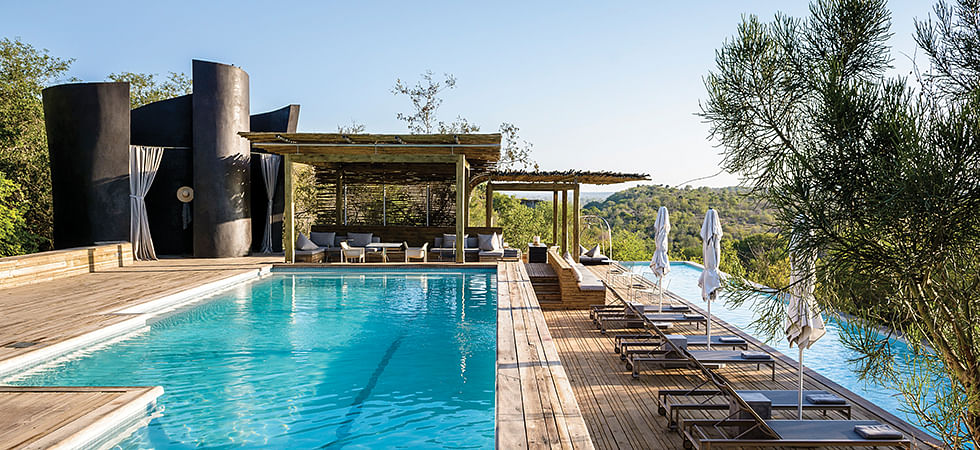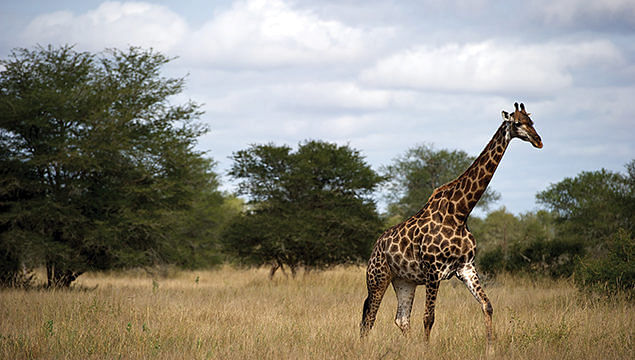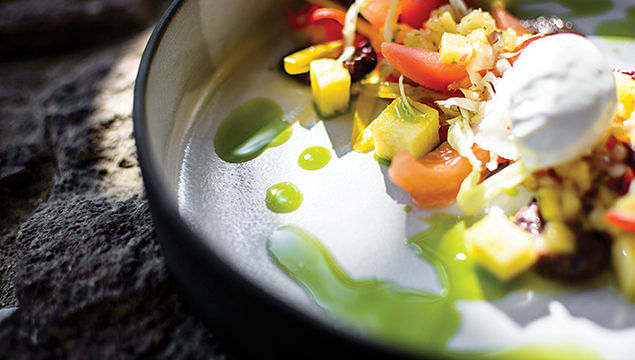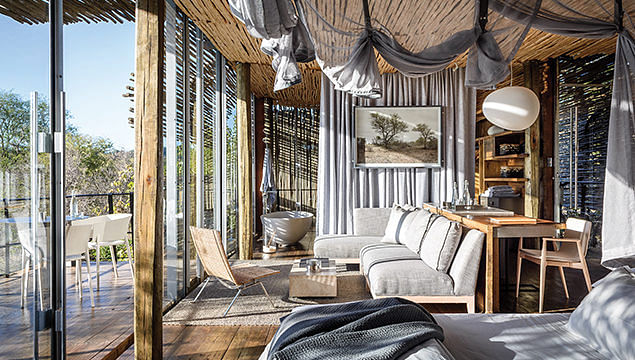
Image: Singita
As the plane descends onto the expanse of Kruger National Park, it’s like a scene from a film with flapping elephant ears already in view, and giraffes peering out over the trees. As the wheels nearly graze the landing strip, we find ourselves swiftly, and somewhat bewilderingly, on the ascent once again. “Sorry I couldn’t risk landing with a wildebeest in the middle of the landing strip,” explains our pilot. Because these are actual problems encountered in one of Africa’s most iconic landscapes teeming with spectacular wildlife.
The 45-minute drive to Singita Lebombo Lodge continues in much the same vein, spotting zebras, impalas and a lone dawdling tortoise before we even arrive at our final destination. The Park authority makes three per cent of the remote areas available as private concessions for a period of 25 years, which Singita was awarded. And what an incredible one it is, having been recently refurbished. Our lodge is suspended above the crocodile-infested N’Wanetsi River with its clean, minimalist design blending seamlessly into the dramatic surrounds, to the extent it’s hard to tell where the room ends, and the wild begins.
Wild Thing

Image: Singita
Of course wilderness is everywhere, and we waste no time diving in. Fuelled by John’s famous ice coffee spiked with Amarula Cream and giraffe-shaped caramel doughnuts, our guide Brian and tracker Charles bundle us into the four-wheel drive and head to one of the world’s oldest and largest national parks, at 4.8 million acres, for the afternoon. Literally within five minutes of leaving camp, we are lucky enough to come across three lions from the Shish pride, lying belly up under a bush, catching respite from the sun. So close in fact that an iPhone was more than adequate to do justice to the magnificent cats lying in mind-bogglingly close proximity.
With 25 years of guiding experience, Brian is described by colleagues as a ‘walking wildlife Wikipedia’ and for good reason, and teamed with tracker Charles, known for his laser vision, together they form the safari dream team. We also have Sean, guide in training, accompany us while learning on the job, demonstrating immense passion that will make him a success in the field. Each session is roughly five hours, and the time zips by, as we keep our eyes peeled for everything, from the most delicate of flowers to colourful European rollers and the more obviously impressive elephants, giraffes, hippos and lions, which Kruger is famous for.
Communication between vehicles plays an integral role in sightings and when Brian is alerted of a male lion and three females by another Singita vehicle, it’s an exhilarating race against time as the sun begins to retreat. At a moment’s notice we find ourselves in the heart of the action, pulling up to the big cats digesting the last of lunch after a radio alert, or standing watch as the guides traverse tall grass to investigate a spot surrounded by vultures, rifles at the ready. There’s no telling what the day will bring, which is what makes safari the ideal blend of relaxation and adrenaline.
On the way back, after sundowners at a different picturesque setting, Charles uses a spotlight to introduce us to the park’s nocturnal inhabitants, including hyenas, scrub hares, jackal, deadly scorpions and a family of porcupines. The beauty is that all guides demonstrate the same enthusiasm as us, as if seeing these creatures for the first time. Brian in particular displays the same degree of glee when spotting a snail or cuckoo as any of the ‘Big Five’.
Base Camp

Image: Singita
The morning safari session begins at 5am, but not without a coffee and muffin before heading out for the day’s first animal fix. The early start is rewarded with an indulgent breakfast on return with still-warm croissants, yogurt, fruit and granola served before you even have a chance to glance at more substantial offerings (eggs benedict and berry pancakes with bacon firm favourites). In the unlikely event you feel peckish, the deli fridge is brimming with gourmet nibbles which you can help yourself to.
If you have the chance, a visit to the spa is a must. The therapists may be small in stature, but give new meaning to deep-tissue massage should you be so inclined, giving tight spots a rigorous working. They are sensitive to individual preferences, and a 90-minute massage concludes with final strokes using hot stones before an invigorating back scrub. Those with dry skin should opt for butter rather than oil, leaving even the most parched skin silky smooth for hours after.
And this is shortly before a tapas lunch, with various daily specials, such as pork belly and pea puree, mushroom on toast, and beef satays. The food is so glorious you will be unable to resist despite feeling stuffed to the gills the majority of the time, particularly as you take in pool views against the dramatic range. It’s easy to see why Executive Chef Frank Louw has gained international acclaim with his consistently superb fare. Dinners of calamari, kudu loin and chocolate fondant live up to hyped expectation, paired with a thoughtfully curated selection of wines, which include exclusive releases, limited single vineyard and rare-auction wines.
Passion Project

Image: Singita
Although the sheer decadence of the glamorous lodge makes for an unforgettable stay, it’s the guides’ infectious enthusiasm for exploration, even at the ungodly hour of 5am, that is most memorable. They are in united supporting the Park’s Conservations efforts against poaching, with resources particularly aimed at protecting the rhino, the largest population of which reside in Kruger. There are also more than 500 bird species, including the highly endangered Hooded Vulture, making it a premiere international birdwatching destination. The guides provide sighting updates to researchers from the Endangered Wildlife Trust and University of KwaZulu-Natal aiding their work in better understanding their distribution in the ecosystem.
On our last night, we are treated to a traditional Boma dinner, an al fresco affair encapsulating African bush culture, where we enjoy a generous spread of local delights with our safari group and guides. We share starters, such as corn fritters, ostrich sausage and homemade pate, before diving into a smorgasbord of barbecued game like tender impala with peppercorn sauce, Boerewors sausage and Cape Verdean lentil bake, under the stars. It’s a great opportunity to learn more of the guides’ fascinating experiences, offering a peek into the many talents of the wait staff, who perform traditional songs and dance around the campfire.
Lingering over malva pudding and milk tarts as we recap the day’s adventures, and attempt to one up each other with Instagram-worthy wildlife shots, our new friends simply add to the magic of these few incredible days. Spending most waking moments together bonds us, and we leave armed with recommendations, travel tips and details to stay in touch. The African safari experience, which so many describe as ‘life changing’, however trite, is just that.
Article first published on Asia Spa

